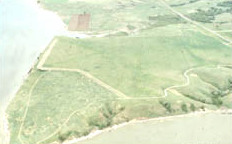Crow Creek Massacre
|
Crow Creek Site
|
|

Aerial view of the site
|
|
| Nearest city | Chamberlain, South Dakota |
|---|---|
| Coordinates | 43°58′48″N 99°19′54″W / 43.98000°N 99.33167°WCoordinates: 43°58′48″N 99°19′54″W / 43.98000°N 99.33167°W |
| Built | 1100 |
| NRHP Reference # | 66000710 |
| Significant dates | |
| Added to NRHP | October 15, 1966 |
| Designated NHL | July 19, 1964 |
The Crow Creek massacre occurred around the mid 1300s AD between Native American groups at a site along the Missouri River in the South Dakota area; it is now within the Crow Creek Indian Reservation. Crow Creek Site, the site of the massacre near Chamberlain, is an archaeological site and a U.S. National Historic Landmark, located at co-ordinates 43°58′48″N 99°19′54″W. An excavation of part of the site was done in the 1950s, with additional excavations in 1978 and later.
Two groups occupied the site in prehistoric times. The Siouan-speaking Middle Missouri people (Initial Middle Missouri variant), ancestral to the historic Mandan people, first occupied the site sometime after about 900 AD. They built numerous earth lodges on the lower portion of the site. Caddoan-speaking Central Plains people (Initial Coalescent variant) moved into the area from southern areas (present-day Nebraska) sometime around 1150 AD. (The historic Arikara are a Caddoan people.) Whether they displaced the earlier group or moved onto an abandoned site is unknown. The Central Plains (Initial Coalescent) people built at least 55 lodges, mostly on the upper part of the site. There is no direct evidence that there was conflict between the two groups, and scholars have found evidence that both cultures changed gradually in relation to the other.
There is evidence that the Central Plains/Initial Coalescent villagers built well-planned defensive works for its village. They were replacing an earlier dry moat fortification by a new fortification ditch around the expanded village when an attack occurred that resulted in the massacre. The attacking group killed all the villagers. Archaeologists from the University of South Dakota, directed by project director Larry J. Zimmerman, field director Thomas Emerson, and osteologist P. Willey found the remains of at least 486 people killed during the attack. Most of these remains showed signs of ritual mutilation, particularly scalping. Other examples were tongues being removed, teeth broken, beheading, hands and feet being cut off, and other forms of dismemberment. In addition to the severity of the attack, most of the people showed signs of malnutrition and many had evidence of being wounded in other attacks. This evidence has suggested to scholars that lives of people of the Initial Coalescent culture were under more stress than was thought; they have theorized that the people were attacked by another group or several groups of the Initial Coalescent culture in the area in competition for arable land and resources.(Zimmerman and Bradley 1993:216)
...
Wikipedia


